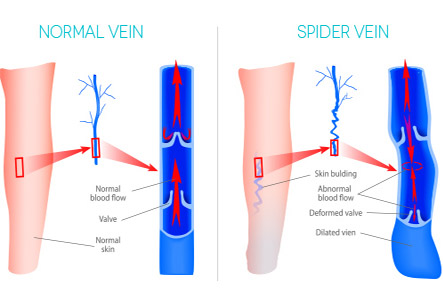Spider Vein Treatment
Introduction
Spider veins or telangiectasia are small clusters of red, blue or purple veins appearing commonly on the skin of thighs, calves and ankle.
The spider veins are sometimes visible in early 20s in some women, but usually they are not obvious until 40 years of age. In men, however, the spider veins are concealed by hair growth on the legs.
Factors contributing to the development of spider veins are:
1. Pregnancy
2. Heredity
3. Hormonal changes
4. Weight gain
5. Occupations or activities requiring prolonged sitting or standing
Spider veins are red, purple, and blue vessels that twist and turn. Spider veins are easily visible through the skin, as well. They are typically visible on the legs and face

Requirements in patient for spider vein treatment:
1. Spider veins on any part of body
2. Good general health
3. Sound mental status
4. Positive outlook and realistic expectations for spider vein treatment
Evaluation before the spider vein treatment includes questions or examinations regarding:
1. Reason for getting treatment for spider veins
2. Expectations about the procedure
3. Desired outcome
4. Family history
5. Existing diseases
6. Medications being taken
7. Drug allergy
Then, the doctor decides the treatment suitable for the patient. Doctor also discusses the possible results of spider vein treatment and risks involved in the therapy selected.
Before the surgery:
1. A proper history, examination and few lab tests and scans are done to determine the general health.
2. Patient should stop anti-inflammatory drugs like aspirin at least a week before surgery.
3. Medications being taken for other conditions like diabetes, heart disease, blood pressure should be continued with advice from the treating doctor.
4. History of smoking or alcohol drinking should be told to the surgeon. Smoking should be stopped if possible as it interferes with the wound healing.
5. Recent history of cough, cold, fever, viral infections, or other illnesses should be informed to the surgeon.
6. Patient is not allowed to eat or drink anything at least 8 to 12 hours before surgery except essential medicines with sips of water.
7. A consent form needs to be signed by the patient to ensure that the procedure, its risks and potential complications are fully understood.
Procedure
• Sclerotherapy:
With each treatment, there is more improvement in the appearance of skin.
This is a common method to treat spider veins. It requires no anesthesia and is usually performed in an outpatient setting. For optimal results, two or more sessions, each requiring less than an hour, are recommended.
In this treatment, a sclerosing solution is injected into the affected vein, resulting in collapse of vein fading it from view. One inch of vein requires one injection. For increasing precision in holding the skin, bright light and magnification are used. A cotton ball and compression tape is applied to each injection site after completion.
• Laser treatment:
In this method, an intense beam of light is used to obliterate the spider vein. It can be used in combination with sclerotherapy. Commonly, two or more sessions are required.
• Intense Pulsed Light (IPL)
This method is used for smaller veins in people with fair skin. However, this treatment requires experience of the surgeon and also there is more discomfort than other treatments.
• Ohmic Thermolysis:
This is relatively new treatment. For this, a small needle is directly placed in the spider vein and heat energy is focused in the vein. This device is safe for all skin types. It can cure some small veins which are difficult to inject.
Risks:
1. Infection
2. Bleeding
3. Unfavorable scarring
4. Poor healing of injection sites
5. Sensory problems in skin
6. Revision surgery
7. Allergies to tape, suture materials and glues, blood products, topical preparations or injected agents
After the surgery:
1. After the treatment, support hose or compression garments need to be worn to help the healing of legs.
2. Some cramping and discomfort can be expected in the legs for the first day or two after treatment.
3. Instructions regarding care of legs and about follow-up are given.
Recovery:
Within the first week
1. Walking should be started.
2. Any dressings or cotton balls are removed according to advice.
3. Stockings need to be worn for about three to six weeks
4. Avoid sitting or standing in one place for long time, heavy lifting, squatting and running.
Results:
With each treatment, there is more improvement in the appearance of skin. However, the treatment cannot prevent recurrence of new spider veins. Repeat treatments are usually needed.